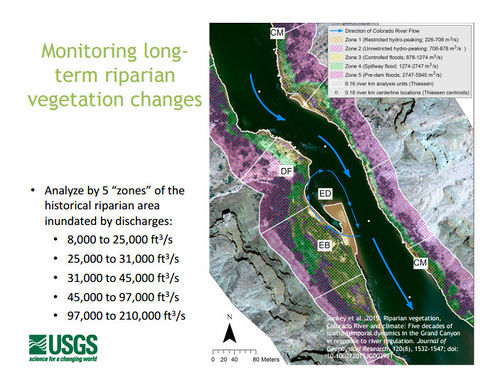Difference between revisions of "ECOSYSTEM"
Cellsworth (Talk | contribs) |
Cellsworth (Talk | contribs) |
||
| Line 28: | Line 28: | ||
==[[Portal:Desired Future Conditions -DFCs| '''Desired Future Condition for Native Species and Biotic Communities''']]== | ==[[Portal:Desired Future Conditions -DFCs| '''Desired Future Condition for Native Species and Biotic Communities''']]== | ||
| − | |||
| − | |||
| − | |||
| − | |||
'''Nonfish Biotic Communities:'''<br> | '''Nonfish Biotic Communities:'''<br> | ||
| Line 64: | Line 60: | ||
|- | |- | ||
|style="color:#000;"| | |style="color:#000;"| | ||
| − | |||
| − | |||
| − | |||
| − | |||
| − | |||
| − | |||
| − | |||
| − | |||
|} | |} | ||
| Line 86: | Line 74: | ||
'''2016''' | '''2016''' | ||
*[http://www.usbr.gov/uc/rm/amp/twg/mtgs/16oct18/Attach_04.pdf Linkages Between Lake Powell Reservoir and the Colorado River Below Glen Canyon Dam] | *[http://www.usbr.gov/uc/rm/amp/twg/mtgs/16oct18/Attach_04.pdf Linkages Between Lake Powell Reservoir and the Colorado River Below Glen Canyon Dam] | ||
| − | |||
| − | |||
| − | |||
| − | |||
| − | |||
| − | |||
| − | |||
*[http://www.usbr.gov/uc/rm/amp/twg/mtgs/16jan26/documents/AR10_Stevens.pdf The Biogeographic Significance of a Large, Deep Canyon: Grand Canyon, Southwestern USA] | *[http://www.usbr.gov/uc/rm/amp/twg/mtgs/16jan26/documents/AR10_Stevens.pdf The Biogeographic Significance of a Large, Deep Canyon: Grand Canyon, Southwestern USA] | ||
*[http://www.usbr.gov/uc/rm/amp/twg/mtgs/16jan26/documents/AR11_Anderson.pdf Ecosystem Monitoring in Glen Canyon National Recreation Area] | *[http://www.usbr.gov/uc/rm/amp/twg/mtgs/16jan26/documents/AR11_Anderson.pdf Ecosystem Monitoring in Glen Canyon National Recreation Area] | ||
| Line 99: | Line 80: | ||
*[http://www.usbr.gov/uc/rm/amp/amwg/mtgs/15feb25/Attach_12.pdf The Stakeholder's Perspective - The National Parks Conservation Association] | *[http://www.usbr.gov/uc/rm/amp/amwg/mtgs/15feb25/Attach_12.pdf The Stakeholder's Perspective - The National Parks Conservation Association] | ||
*[http://www.usbr.gov/uc/rm/amp/amwg/mtgs/15feb25/Attach_11.pdf Lower Colorado River Multi-Species Conservation Program Update] | *[http://www.usbr.gov/uc/rm/amp/amwg/mtgs/15feb25/Attach_11.pdf Lower Colorado River Multi-Species Conservation Program Update] | ||
| − | |||
*[[Media:USGS State of the CR ecosystem in the Grand Canyon- c1282.PDF | USGS State of the Colorado River Ecosystem in the Grand Canyon- c1282]] | *[[Media:USGS State of the CR ecosystem in the Grand Canyon- c1282.PDF | USGS State of the Colorado River Ecosystem in the Grand Canyon- c1282]] | ||
| Line 114: | Line 94: | ||
|style="color:#000;"| | |style="color:#000;"| | ||
| − | |||
| − | |||
| − | |||
| − | |||
| − | |||
| − | |||
| − | |||
| − | |||
<br> | <br> | ||
|} | |} | ||
Revision as of 19:59, 22 February 2017
|
|
Natural ProcessesRestore, to the extent practicable, ecological patterns and processes within their range of natural variability, including the natural abundance, diversity, and genetic and ecological integrity of the plant and animal species native to those ecosystems. Desired Future Condition for Native Species and Biotic CommunitiesNonfish Biotic Communities: CRE Riparian Domain: |
| --- |
--- |
--- |
|---|
|
|
